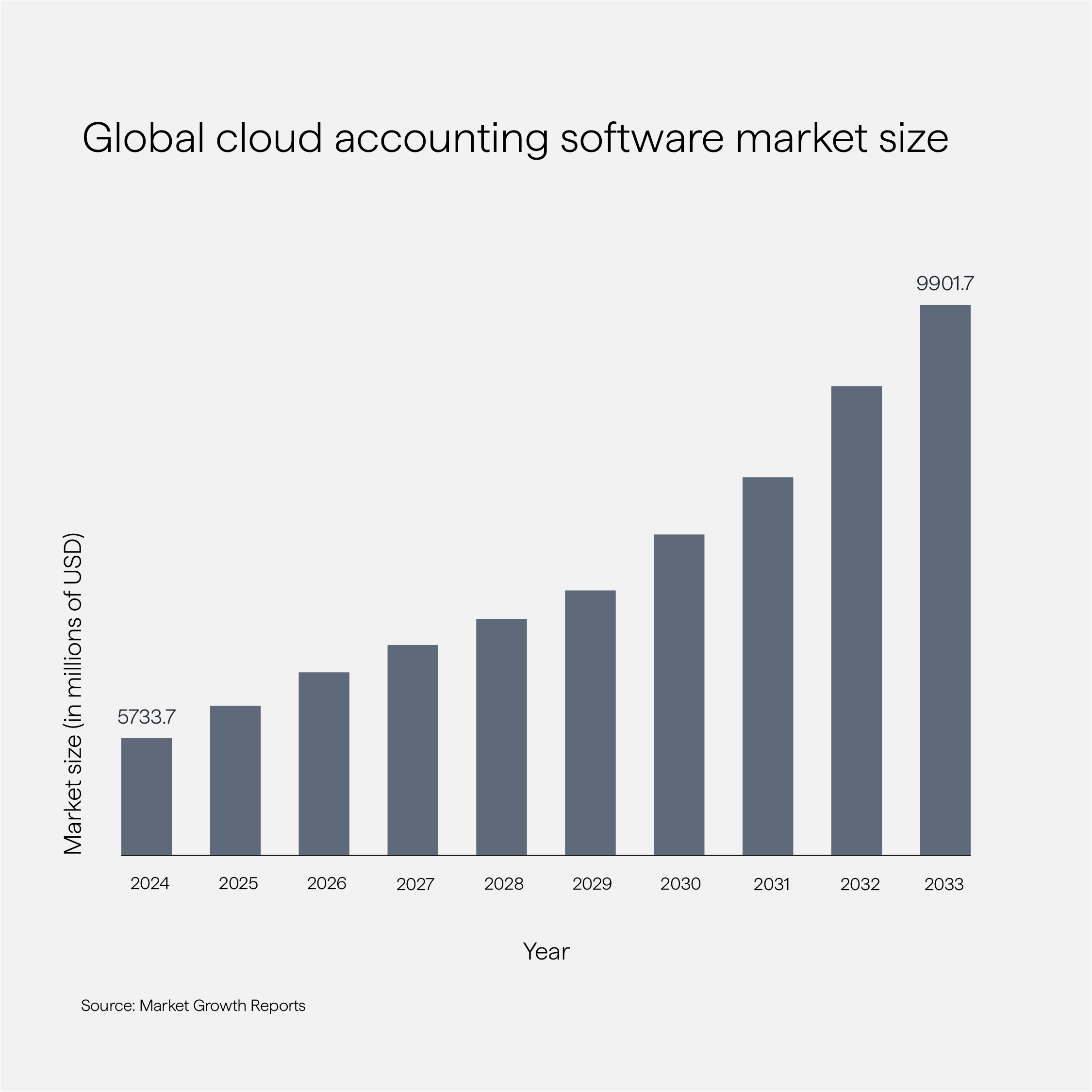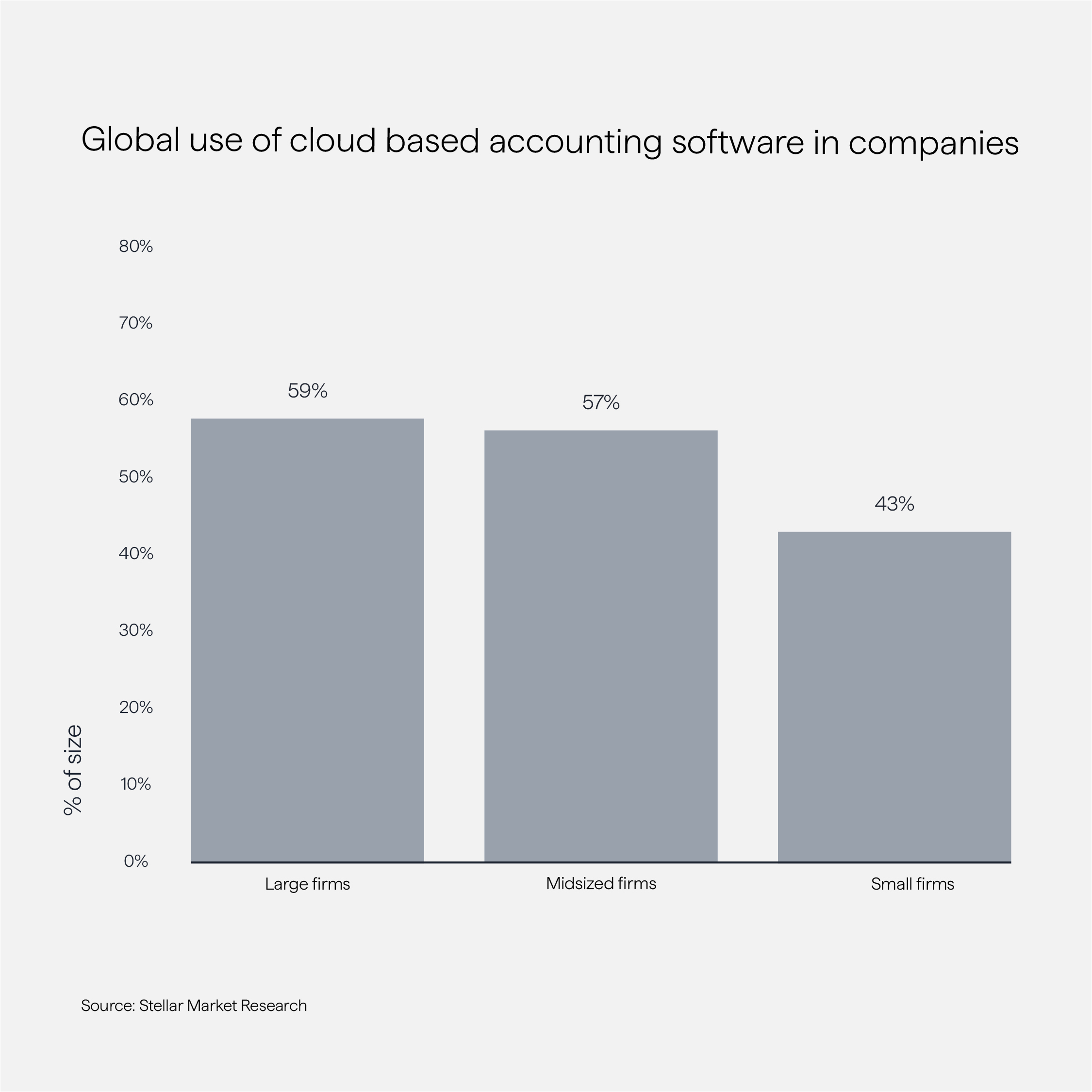Why embedded banking is the next big thing in accounting software
6 minute read


With a market value of $5.7 billion, and a projected compound annual growth rate of 6.2% between now and 2033, the cloud-based accounting software industry's future looks very bright.
But, beyond the headline stats, the reality on the ground is much more nuanced.
The regulatory environment, particularly in Europe, is increasingly complex. As an accounting software provider, you now have to contend not only with GDPR, but also with the VAT in the Digital Age package, DORA, and, most recently, the AI Act.
More to the point, the market is becoming more saturated and fragmented, with smaller providers aggressively targeting SMEs — the sector's key growth area.
The good news? You don't need to make big strategic moves to sharpen your competitive edge.
With embedded banking technology, you can enhance convenience and boost loyalty, engagement, and trust by leaning into your most valuable asset: your customers' financial data.

The compelling case for incorporating banking products into accounting software
Competing with banks — a key accounting software industry partner — might seem counter-intuitive.
But, while traditional banking is operationally very different to running a software business, banking products are complementary — even a natural extension — of accounting software vendors' services.
Offering accounts, cards, and loans alongside accounting tools rounds out and personalizes your platform, making it more valuable to end-users.
Deeper insights into end-users' current and future needs make it possible to offer highly relevant and tailor-made products at the right time. The end-user also benefits through real-time visibility, improving budgeting and forecasting accuracy, and faster access to lines of credit and other products.
The leaner, more streamlined workflow also reduces compliance headaches, and the number of integrations and other moving parts they need to juggle. Plus, more data enables more accurate decisioning. Which translates into better rates without a corresponding increase in risk.
Crucially, in an embedded finance model, banks are still key partners. The main difference from the traditional partnership model is that, instead of providing access to their customer data, banking partners give access to a product: a banking license, and front-end and back-end systems.
Findlay Guerin , co-founder of B2B Growth Consultancy Stratinn, puts it in a nutshell:
By embedding financial management tools, accounting platforms can offer comprehensive end-to-end experiences for handling SME budgets. From onboarding to payments and automated reconciliation – elevating them from a replaceable reporting tool to an indispensable operating system for SMEs.
How embedded finance works
It's useful to think of embedded finance as plugging your laptop into an electrical socket.
Your apps, data, and preferences are all stored on your laptop, and you're in charge of the workflow. But, instead of generating your own electricity, with all the complexities this entails — building and maintaining infrastructure, regulatory compliance, and other operational issues that are very far-removed from your core expertise — you get it from a third party.
In an embedded finance context, your banking-as-a-service partner is your electricity provider and its embedded finance APIs are your electrical sockets.
Your business, on the other hand, is the laptop. You're in charge of your data and of the banking products' characteristics and UX, owning the customer relationship without having to become a bank yourself. Alongside control, the biggest benefits of this arrangement are speed and cost-effectiveness.
The process of getting a banking license alone can take 12 to 24 months or longer. By contrast, working with a banking-as-a-service provider enables you to go to market much faster.
Case in point, when ADAC — Europe's largest car club — switched to Solaris, the process took about two years. And this wasn't a new deployment, but an extremely complex migration, involving the details of 1.1 million active credit card users.
Needless to say, embedded finance is also good for the bottom line.
A 2025 William Blair and Stripe joint report found that, compared to software-only platforms, SaaS platforms with embedded finance capabilities have 7% higher EBITDA and 5% higher revenue growth.
Valuation multiples are also higher: by 23% for revenue multiples and 19% for EBITDA multiples. In plainer terms, adding embedded finance capabilities to your platform makes it more likely you'll attract investors, and more likely that these investors will be prepared to put forward higher amounts.

Embedded finance for accounting software vendors in practice: The use-cases with the highest USP potential
So, how does embedded finance round out accounting platforms and make them more valuable to end-users?
In our view, the three most promising use cases for cloud-based accounting software providers are:
-
Bulk payments
-
Expense management
-
Lending
Embedded payments: one-click settlement for multiple bills
SEPA instant may have launched in 2017, but, in Germany, B2B payments continue to be exceedingly complex and admin-heavy.
The typical workflow involves manual data input and payment runs, followed by exporting multiple CSV files for reconciliation, so that the average business loses one working day a week to admin.
Embedding payments into accounting software makes the process fully digital and near-instant. Through our partnership with ACI, for instance, Solaris can enable account-to-account payments and card processing, with AI-powered fraud prevention built-in.
With the Instant Payments Regulation's obligations set to kick in imminently and businesses under growing pressure to update their systems, this is an especially timely and compelling opportunity.
Embedded expense management: the best of all worlds
Most SMEs manage business expenses in one of three ways:
-
Employees pay, then file for reimbursement
-
Corporate credit cards, debit cards, or prepaid cards
-
They use a spend management software platform
The third option is widely touted as the best of both worlds.
Employees don't need to fill out expense reports, which creates manual work for them and for the finance team. And, they aren't out of pocket while they wait for reimbursement. An issue that, in the current economic climate, runs the risk of causing unnecessary stress and financial hardship.
At the same time, finance teams can see employee spending in real time, carry out reconciliations more quickly, and even set spending limits or assign different rules and budgets depending on role and seniority.
The problem? Spend management tools still need to be integrated with accounting software for the end-user to get the full picture, adding technical complexity. Most of the time, the end-user will also need to flip between systems to make the most of the data.
When spend management capabilities are integrated into accounting software, the end user gains more visibility and control, from one pane of glass.
From a provider's perspective there's also the benefit of turning a cost center into a revenue generator. Solaris' embedded card partners, for instance, earn a share of interchange fees.
The additional spending data is also extremely valuable for personalization. For example, SpendIt uses it to tailor its rewards to individuals' preferences, offering perks like cashback from their most frequently visited merchants.
Embedded lending: Just-in-time credit facilities at better rates with lower risk
In 2025, 81% of German businesses reported payment delays.
The average reported delay was 32 days, with only 12% experiencing delays of six months or more. That said, a month-long delay can still have a significant impact on cashflow, particularly with German banks taking an increasingly conservative approach to SME lending.
This gap is banks' loss and accounting software providers' gain. Access to granular, real-time data into individual businesses' incomings and outgoings puts accounting software providers in a position where:
-
They can anticipate potential cash flow problems and offer overdraft facilities or other types of credit such as factoring — borrowing using unpaid invoices as collateral — at the point when the business is likely to need them most
-
They have an extremely in-depth and accurate picture of the business' health at their fingertips, enabling faster decisions and better risk scoring
Research also suggests embedded lending boosts customer lifetime value by 40% to 60%, mainly because, once a customer uses a credit facility and appreciates its benefits and ease of use, they'll likely use it again.
Growth isn't the biggest challenge accounting software vendors face. Differentiation is.
The biggest threat to accounting software platforms isn't supply and demand. It's competition from firms that, traditionally, weren't involved in accounting, like expense management platforms and open banking providers.
Embedded finance is how accounting software providers can seize back the initiative. By using the in-depth data sets they already have at their disposal, they can build uniquely personalized financial services products that make them truly irreplaceable.
Want to enrich your accounting software platform with value-added, highly targeted embedded finance products?
Let us show you how!